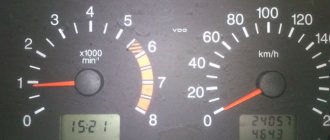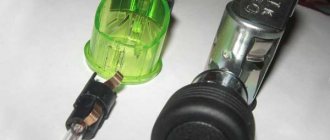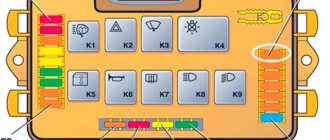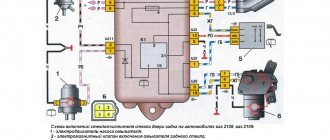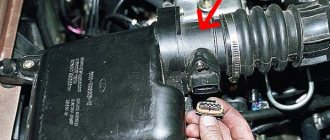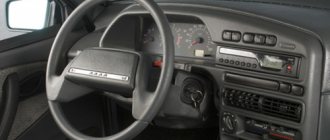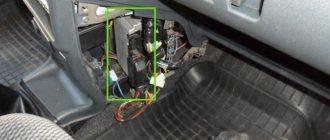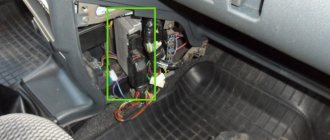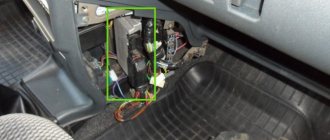Drivers of old Russian cars that are not equipped with air conditioning use a cabin heater not only in winter, but also during rain. High humidity condenses on the windshield, reducing the driver's visibility. If the stove on a VAZ-2114 does not work, then the reason is not necessarily related to a breakdown of the vehicle’s components. In most cases, you can solve the problem yourself.
Causes of malfunctions
In winter, when the cabin heater stops working, you feel discomfort: it is cold in the car and the windows freeze. To figure out why the stove on the VAZ-2114 does not work, the car should be driven into the garage.
Before starting work, you need to become familiar with the structure of the vehicle's heating system. The structure consists of the following elements:
- heater radiator;
- pipes supplying heated coolant;
- faucet that regulates the flow of liquid;
- interior dampers directing the air flow;
- a fan that creates air flow;
- fan speed controller;
- a pump that creates a flow of heated liquid;
- thermostat, which is responsible for the direction of movement of the coolant.
When all these elements function normally, the car interior is warm. But when one of them stops working, interruptions in heating occur.
If the fan of the VAZ-2114 heater does not work, the reasons most often given by auto mechanics are the following:
- fan failure;
- fuse blown;
- lack of contact in the electrical circuit;
- heater radiator malfunction;
- The thermostat does not respond to temperature changes;
- faucet breakdown;
- low pressure in the coolant circulation system;
- airlock;
- The engine cylinder head gasket was blown.
The stove on the VAZ 2114 stopped working
In winter, driving without interior heating is a dubious pleasure. But VAZ 2114 owners often encounter this situation, because their stove stops working.
Today we will understand the structure of the stove, consider the main causes of malfunctions and ways to eliminate them. Alas, the stove may not heat for a whole list of different reasons. Your task as a car owner is to find these causes and eliminate them. Do it yourself or with the help of car services, decide for yourself.
car heater
Elimination of electrical circuit defects
If, when you turn on the heating by turning the handle, the stove does not work and you cannot hear the electric motor running, then first of all the fuse located in the control circuit is checked.
To check its integrity, you need to look into the engine compartment. There is a mounting block in the niche under the windshield. The fuse responsible for the operation of the fan motor is marked F7 and has a rating of 20A.
By replacing it with a similar one, the performance of the engine is checked. If this procedure is not successful, you need to check the contact relay. When the on-board network is turned on, it experiences significant loads. To reduce them, contact relays are used. The same ones are installed in the heater circuit. When the relay is faulty, the fan does not turn on every time, especially when the engine is cold.
This is interesting: Do-it-yourself glass repair and installation in theory
The reason may be problems with the contact block. The contact connectors are located in the engine compartment and are exposed to high humidity. Therefore, they are intensively oxidized, this leads to a lack of contact, so the fan may stop working.
The electrical circuit can be restored by disconnecting the terminals and then cleaning the terminals. But if there is severe corrosion, the contacts break, and then the contact group needs to be replaced.
The next part that can affect the operation of the furnace is the switch. The fan speed setting is set by a switch. The internal mechanism includes contacts that wear out over time. Repair is usually impractical; it is easier to replace the switch with a new one.
The resistor included in the control circuit regulates low and medium speeds. If, when moving the handle to the extreme right position, the engine runs at maximum speed, then the reason is in the resistor and it must be replaced.
The last element of the electrical circuit is the electric motor itself with an impeller that supplies air. It refuses to work if the insulating layer of varnish burns through and an interturn short circuit occurs. Previously we used motor rewinding services. But today it is practically not used, so you will have to purchase a new motor.
Why do problems occur in the heating system?
When the heater on a VAZ 2114 does not turn on, this is a serious problem for drivers at any time of the year, but with the onset of the cold season it becomes especially important. The main reasons why the heating system refuses to work are various reasons, ranging from the electrical system to problems with the pump.
Operating principle of the stove:
- When adjusting the temperature of the air supply to the solon, it is necessary by opening or closing the heater tap.
- It is thanks to the tap of the heating system that cooling liquid enters the radiator, which contributes to the formation of heat. The temperature of the coolant with a heated engine reaches about 94 degrees.
- By switching the stove to different speed modes from the first to the third, the speed of the heater fan is adjusted, facilitating the flow of warm or cooled air into the cabin, depending on the position of the tap.
- Using panel dampers, you can regulate the air flow exactly in the direction you need.
Knowing the principle of operation of the heater system, you can understand where the cause of problems in the car lies.
Problems with the cooling system
When the heater on a VAZ-2114 does not work, reasons other than electrical may lie in the coolant circulation system:
- Air lock . As the coolant cools, air accumulates in the upper part of the radiator. Subsequently, air enters the thermostat and a large circle of coolant movement is blocked. The heater core remains cold. There are many ways to fix the problem. But the easiest thing is to squeeze out excess air from the system. To do this, unscrew the cap from the tank. With the engine running, the cold hose is intensely compressed, causing air to escape into the reservoir. If this method does not work, you will have to disconnect the hose to remove the air lock.
- Radiator . Few people devote time to maintaining their car, and especially the heating system. The internal space becomes clogged with dirt, which impedes the flow of coolant. The outer multi-cellular surface becomes clogged with dust and foreign objects, which interferes with heat transfer. In this case, only cleaning the radiator and replacing the cabin filter will help.
- Water pump . Wear of intake blades leads to a decrease in productivity and, consequently, a drop in pressure. Reduced idle pressure is unable to supply heated coolant to the radiator. Only high engine speeds allow you to create the necessary pressure.
- Low coolant level. An antifreeze level below the minimum provokes airing of pipelines. You just need to add antifreeze to the maximum level.
- Cylinder head gasket . A gradual decrease in coolant level, intense white smoke from the exhaust system and the smell of gasoline (oil) in the tank indicate a burnt-out gasket. Through the gap that appears, antifreeze enters the cylinders and into the crankcase with oil. Replacing the gasket requires removing a large number of parts.
- Thermostat . The operating principle of the thermostat is based on the property of a certain metal to change its original shape when the temperature rises. If the element fails, the coolant moves in a small circle without entering the heater radiator. In this case, only replacing the thermostat will help.
- Faucet. It regulates the flow of coolant, that is, the temperature inside the car. If it breaks, the fluid flow stops. Although it is held on by two screws, it is installed in a hard-to-reach place, under the dashboard, which is associated with certain difficulties.
- Hoses . Connecting rubber hoses become unusable after prolonged use. They crack and break. Through the formed cracks, the system depressurizes, and consequently, antifreeze leaks, air gets inside, etc.
This is interesting: Mitsubishi Pajero engines (Mitsubishi Pajero)
Blown cylinder head gasket
Ineffective operation of the stove may occur due to a burnt-out cylinder head gasket. The cause can be determined by certain signs:
- the coolant smells like a mixture of gasoline and exhaust gases;
- the smell of antifreeze appears in the engine oil;
- White thick smoke comes out of the muffler.
The appearance of white smoke cannot go unnoticed, so when this sign appears, you need to check and replace the gasket.
The electric motor is actively involved in the operation of the stove; it often breaks down and burns out. Replacing it with a new element is not in all cases the only solution to the problem. There is a possibility that the motor has not burned out, then it can be repaired. You need to check all operating modes of the stove and make sure that the ignition relay is working.
In order to avoid problems with the stove in the future, you need to periodically disassemble and clean the radiator and pipes, change the filter on time, add antifreeze, securely fix the tap, and then your stove will reliably delight you with warmth.
Fan replacement
If the stove fan stops working, or it makes strange sounds, then it is necessary to dismantle it, clean it or replace it. However, you should not rush to replace it; first you need to make sure that the brushes of the mechanism are intact, in which case replacement will not be required. Getting to this part is not so easy, but for cars with the Lada “tenth” family design, there is a time-tested reliable way to get to the fan:
- Release the right side of the instrument panel by unscrewing the eight screws, then the panel must be lifted.
- Afterwards it is necessary to remove the standard sound insulation of the engine shield.
- Next, you will need to take a position in the cabin so that your shoulders rest on the mat; this is the easiest way to reach the fan.
Removing the fan is quite simple. All you need is the necessary tools and a little time. By unscrewing the three screws of the casing cover and removing the frame of the radiator pipe seal, you can remove the device. But before changing a part, you need to determine whether it works or not.
After all, it often happens that a dismantled fan spins and functions normally, but as soon as it is put back in place, it immediately ceases to fulfill its direct duties. The reason for this is most often accumulated small particles that prevent normal contact in the mechanism.
Choosing a new heater radiator
New cars of the VAZ family are equipped with heat exchangers from the Dimitrovgrad Automotive Component Plant. Their production uses technology from the French company VALEO (SOFICA).
The original heater radiator produced by DAAZ has small honeycombs
When purchasing a new radiator, the first things to consider are:
- frequency of installation of transverse plates;
- strength and rigidity of the plates;
- the presence of plastic swirlers in round aluminum tubes.
DAAZ radiators differ from their analogues in their tiny honeycombs, in which the transverse plates are located at a very small distance from each other. Due to this, the air remains in contact with the core for a long time and heats up more. The high rigidity of the plates does not allow them to deform under light impacts.
MODE SWITCH PANEL
Sometimes the stove cannot be turned on because the switches on the control panel fail. You can also fix this problem yourself. You must first remove the handles and remove the stove mode switching unit. When removing the panel body, pay attention to the latches. They need to be pressed with a thin screwdriver, and at the same time pulled out. When the latches are removed, the switch housing housing slides out of its socket easily. Here you can already see what kind of breakdown occurred and what parts can be replaced.
A car's heater, at first glance, is a simple unit in a car, but it is closely connected with the entire structure of the car, and primarily with the cooling system. Using the heat generated by the engine, the car heater does not require additional electricity and fuel. But often it is the failure of the interior heating system that can be the first signal of more serious defects.
